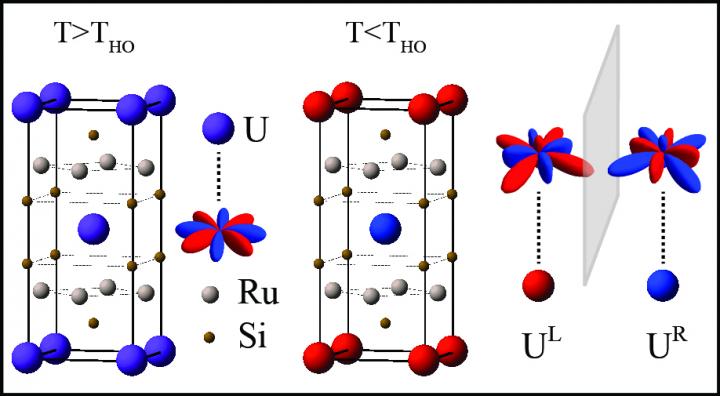Rutgers-led team makes stride in explaining 30-year-old 'hidden order' physics mystery

A Rutgers-led team of physicists discovered a new explanation for the 'hidden order' puzzle that has vexed physicists for 30 years. In an extremely pure crystalline sample of a uranium, ruthenium and silicon compound below the hidden order temperature of 17.5 degrees Kelvin, electron orbital patterns in uranium atoms in adjacent crystal layers become mirror images of each other (right side of illustration). Above the hidden order temperature, electron orbitals in the uranium atoms are the same (left side of illustration). Credit: Hsiang-Hsi Kung, Rutgers University
A new explanation for a type of order, or symmetry, in an exotic material made with uranium may lead to enhanced computer displays and data storage systems, and more powerful superconducting magnets for medical imaging and levitating high-speed trains, according to a Rutgers-led team of research physicists.
The team's findings are a major step toward explaining a puzzle that physicists worldwide have been struggling with for 30 years, when scientists first noticed a change in the material's electrical and magnetic properties but were unable to describe it fully. This subtle change occurs when the material is cooled to 17.5 degrees above absolute zero or lower (a bone-chilling minus 428 degrees Fahrenheit).
“This 'hidden order' has been the subject of nearly a thousand scientific papers since it was first reported in 1985 at Leiden University in the Netherlands,” said Girsh Blumberg, professor in the Department of Physics and Astronomy in the School of Arts and Sciences.
Collaborators from Rutgers University, the Los Alamos National Laboratory in New Mexico, and Leiden University, published their findings this week in the web-based journal Science Express, which features selected research papers in advance of their appearance in the journal Science. Blumberg and two Rutgers colleagues, graduate student Hsiang-Hsi Kung and professor Kristjan Haule, led the collaboration.
Changes in order are what make liquid crystals, magnetic materials and superconductors work and perform useful functions. While the Rutgers-led discovery won't transform high-tech products overnight, this kind of knowledge is vital to ongoing advances in electronic technology.
“The Los Alamos collaborators produced a crystalline sample of the uranium, ruthenium and silicon compound with unprecedented purity, a breakthrough we needed to make progress in solving the puzzle of hidden order,” said Blumberg. Uranium is commonly known as an element in nuclear reactor fuel or weapons material, but in this case, physicists value it as a heavy metal with electrons that behave differently than those in common metals.
Under these cold conditions, the orbital patterns made by electrons in uranium atoms from adjacent crystal layers become mirror images of each other. Above the hidden order temperature, these electron orbitals are the same. The Rutgers researchers discovered this so-called “broken mirror symmetry” using instrumentation they developed – based on a principle known as Raman scattering – to distinguish the pattern of the mirror images in the electron orbitals.
Blumberg also credits two theoretical physics professors at Rutgers for predicting the phenomenon that his team discovered.
“In this field, it's rare to have such predictive power,” he said, noting that Gabriel Kotliar developed a computational technique that led to the prediction of the hidden order symmetry. Haule and Kotliar applied this technique to predict the changes in electron orbitals that Kung and Blumberg detected.
At still colder temperatures of 1.5 degrees above absolute zero, the material becomes superconducting – losing all resistance to the flow of electricity. While not practical for today's products and systems that rely on superconductivity, the material provides new insights into ways that materials can become superconducting.
The hidden order puzzle has also been a focus of other Rutgers researchers. Two years ago, professors Premala Chandra and Piers Coleman, along with Rutgers alumna Rebecca Flint, published another theoretical explanation of the phenomenon in the journal Nature.
The Leiden University collaborator, John Mydosh, is a member of the laboratory that discovered hidden order in 1985.
“The work of Blumberg and his team is an important and viable step towards the understanding of hidden order,” Mydosh said. “We are well on our way after 30 years towards the final solution.”
Working with Kung, Blumberg and Haule at Rutgers were Verner Thorsmølle and Weilu Zhang. The Los Alamos National Laboratory collaborators are Ryan Baumbach and Eric Bauer.
The research was funded by the National Science Foundation and the U.S. Department of Energy's Office of Basic Energy Sciences, Division of Materials Sciences and Engineering.
Media Contact
All latest news from the category: Physics and Astronomy
This area deals with the fundamental laws and building blocks of nature and how they interact, the properties and the behavior of matter, and research into space and time and their structures.
innovations-report provides in-depth reports and articles on subjects such as astrophysics, laser technologies, nuclear, quantum, particle and solid-state physics, nanotechnologies, planetary research and findings (Mars, Venus) and developments related to the Hubble Telescope.
Newest articles
Faster, more energy-efficient way to manufacture an industrially important chemical
Zirconium combined with silicon nitride enhances the conversion of propane — present in natural gas — needed to create in-demand plastic, polypropylene. Polypropylene is a common type of plastic found…

Energy planning in Ghana as a role model for the world
Improving the resilience of energy systems in the Global South. What criteria should we use to better plan for resilient energy systems? How do socio-economic, technical and climate change related…

Artificial blood vessels could improve heart bypass outcomes
Artificial blood vessels could improve heart bypass outcomes. 3D-printed blood vessels, which closely mimic the properties of human veins, could transform the treatment of cardiovascular diseases. Strong, flexible, gel-like tubes…





















